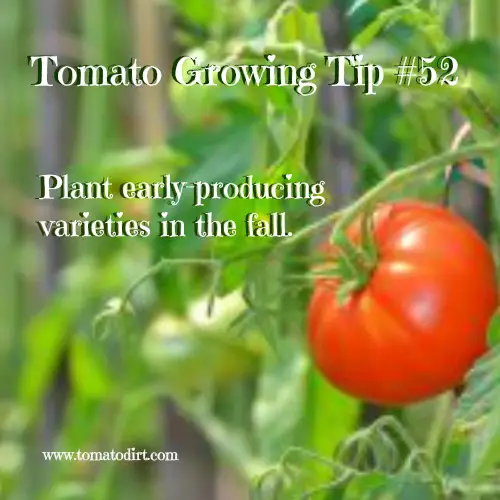FREE: 10 Must-Know Tomato Growing Tips Get The Guide
Read our affiliate disclosure here.
Should I Plant Second Season Tomatoes - and When?
Since 2010, Tomato Dirt has garnered 4.8+ million views, making it the web’s leading online source for growing tomatoes in the home garden. Award-winning writer and Tomato Dirt owner Kathy Widenhouse has helped thousands of home gardeners grow healthier tomatoes. Be one of them when you get Tomato Dirt’s Growing Guide here.
Second season tomatoes (also called fall tomatoes or late tomatoes) are an entirely new crop which you plant midsummer and harvest in the fall.
You set them in the ground just as your first crop slows production, leaves brown, or plants start to die off.
By planting a new wave of plants, you can continue to harvest and enjoy fresh tomatoes well into autumn.
How can you know if second wave of tomato plants is the right route for you?
The choice boils down to three questions:
- Is your growing season long enough?
- Will your current tomato plants keep producing fruit or are they fizzling out – and you think it would be great to have more?
- Are you willing to put in the effort for a whole new crop?
You can figure out if you’ve got enough time on the calendar by finding out your local projected first frost date. Count back about three months to give you an idea about when to start tomato seeds – a few weeks less for purchased seedlings or cuttings.
Try short-season varieties or cold-hardy varieties
Choose varieties that produce fruit in lowest number of days to maturity – fewer than 65 days, preferably as close to 50-55 days as possible.
This will allow fruit to mature sooner than later, a helpful way to go when you're on a potentially limited timeline.
The “days to maturity” number identifies the number of days the plant needs to produce fruit once it is set in the garden as a transplant.
(Browse short season tomato varieties).
What to do
Choose from 3 options to grow and prepare second season tomatoes. Make sure transplants have large root systems before setting them in the garden.
- Grow from seed. Grow plants from seeds in large pots. Keep them in bright shade outside until they are ready to set out in the garden – about 6 weeks after germination. Allow at least 3 months from planting your seeds to your region’s projected first frost date.
- Grow plants. Purchase transplants in late July or early August and then move them to larger pots where they will develop size.
- Grow from cuttings. Take cuttings from your current tomato plants, root them, and plant them in large pots to mature before setting them out in the garden.
Take these special steps with second season tomatoes
Grow a strong seedling. In order for your plants to survive outdoors in late summer, the root ball needs to be substantial. No matter which starting option you choose – seeds, plants, or cuttings – nurture the plant until it is a healthy one-gallon transplant.
Watch the heat. In the spring, you need to be careful about cool temperatures and even overnight frost. But in the fall, you need to be careful that temperatures aren’t too hot for tomato seedlings. Plants need to be more robust when you set them out in midsummer to withstand high temperatures. Help the process along with hardening off in reverse. Keep plants outside in the coolest place possible (such as a shaded spot), gradually moving them into the sun. Make sure they don’t dry out.
Water faithfully. You need to be especially diligent about watering newly-planted fall tomatoes once they are set out in the garden.
Second season tomatoes vs. late season tomatoes: what's the difference?
Second season tomatoes are a completely new crop planted in the middle of the summer which you plan to harvest in the fall.
Late season tomatoes are tomato varieties that take longer to mature than others. They usually require 80-90 days or more to produce mature fruit, once seedlings are set in the garden. Early season tomatoes (or short-season tomatoes) need about 45-65 days. Midseason tomatoes are in between with a little overlap.
More on fall tomatoes
When Should You Plant Fall Tomatoes?
Best fall tomato varieties ...
3 keys to growing fall tomatoes successfully ...
How to take fall tomato cuttings to root second season tomatoes ...
How to root fall tomatoes from existing plants ...
More on our Late Season Tomatoes Pinterest Board ...
Return from Second Season Tomatoes to Tomato Dirt home
As an Amazon Associate and Rakuten Advertising affiliate I earn from qualifying purchases.
SHARE THIS PAGE:
FREE! 10 Must-Know Tomato Growing Tips: 20-page guide
Get yours here:




